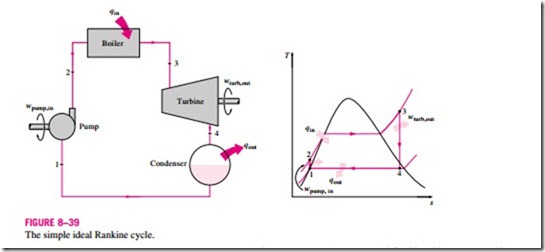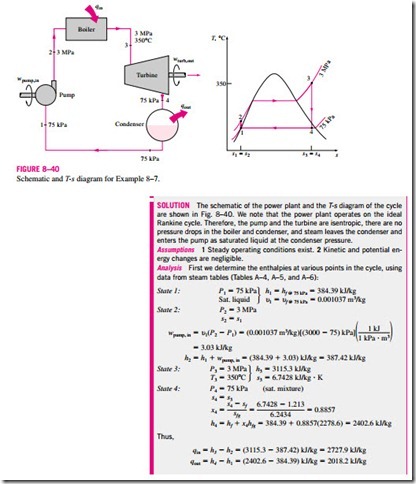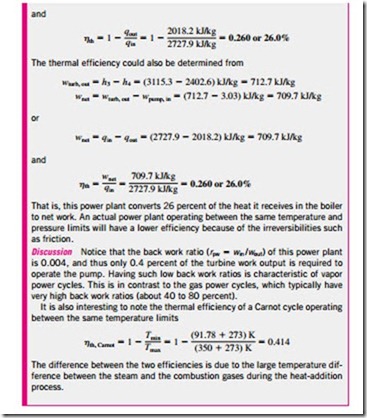■ RANKINE CYCLE: THE IDEAL CYCLE FOR VAPOR POWER CYCLES
Many of the impracticalities associated with the Carnot cycle can be eliminated by superheating the steam in the boiler and condensing it completely in the condenser, as shown schematically on a T–s diagram in Fig. 8–39. The cy- cle that results is the Rankine cycle, which is the ideal cycle for vapor power plants. The ideal Rankine cycle does not involve any internal irreversibilities and consists of the following four processes:
1-2 Isentropic compression in a pump
2-3 Constant pressure heat addition in a boiler
3-4 Isentropic expansion in a turbine
4-1 Constant pressure heat rejection in a condenser
Water enters the pump at state 1 as saturated liquid and is compressed isentropically to the operating pressure of the boiler. The water temperature in- creases somewhat during this isentropic compression process due to a slight decrease in the specific volume of the water. The vertical distance between states 1 and 2 on the T-s diagram is greatly exaggerated for clarity. (If water were truly incompressible, would there be a temperature change at all during this process?)
Water enters the boiler as a compressed liquid at state 2 and leaves as a superheated vapor at state 3. The boiler is basically a large heat exchanger where the heat originating from combustion gases, nuclear reactors, or other sources is transferred to the water essentially at constant pressure. The boiler, together with the section where the steam is superheated (the superheater), is often called the steam generator.
The superheated vapor at state 3 enters the turbine, where it expands isentropically and produces work by rotating the shaft connected to an electric generator. The pressure and the temperature of the steam drop during this process to the values at state 4, where steam enters the condenser. At this state, steam is usually a saturated liquid–vapor mixture with a high quality. Steam is condensed at constant pressure in the condenser, which is basically a large heat exchanger, by rejecting heat to a cooling medium such as a lake, a river, or the atmosphere. Steam leaves the condenser as saturated liquid and enters the pump, completing the cycle. In areas where water is precious, the power plants are cooled by air instead of water. This method of cooling, which is also used in car engines, is called dry cooling. Several power plants in the world, including some in the United States, use dry cooling to conserve water.
Remembering that the area under the process curve on a T–s diagram represents the heat transfer for internally reversible processes, we see that the area under process curve 2-3 represents the heat transferred to the water in the boiler and the area under the process curve 4-1 represents the heat rejected in the condenser. The difference between these two (the area enclosed by the cycle curve) is the net work produced during the cycle.
Energy Analysis of the Ideal Rankine Cycle
All four components associated with the Rankine cycle (the pump, boiler, turbine, and condenser) are steady-flow devices, and thus all four processes that make up the Rankine cycle can be analyzed as steady-flow processes. The kinetic and potential energy changes of the steam are usually small relative to the work and heat transfer terms and are therefore usually neglected. Then the steady-flow energy equation per unit mass of steam reduces to
The conversion efficiency of power plants in the United States is often ex- pressed in terms of heat rate, which is the amount of heat supplied, in Btu’s, to generate 1 kWh of electricity. The smaller the heat rate, the greater the efficiency. Considering that 1 kWh = 3412 Btu and disregarding the losses associated with the conversion of shaft power to electric power, the relation between the heat rate and the thermal efficiency can be expressed as
For example, a heat rate of 11,363 Btu/kWh is equivalent to 30 percent efficiency.
The thermal efficiency can also be interpreted as the ratio of the area en- closed by the cycle on a T–s diagram to the area under the heat-addition process. The use of these relations is illustrated in the following example.
Incoming search terms:
- rankine cycle
- ideal cycle rankine cycle
- ideal cycle for all power cycle
- https://yandex ru/clck/jsredir?from=yandex ru;search;web;;&text=&etext=1841 jYt2AarozsJBwSbdWyg3QjeIRlK-Zas50jfbTPg0uyq3EVtkiLLyTU393zuTV_zFoUByVz1ZoW4B3MVph2CZeA 61575ccb6107d0f60d613b6f7c944e6693bd06a4&uuid=&state=_BLhILn4SxNIvvL0W45KSic
- https://yandex ru/clck/jsredir?from=yandex ru;search;web;;&text=&etext=1840 auJCl3wE-ZP6-KncapyWd7V0EJjvqm5MC-vfL_HMgkpSHVk3K1-iUlY-NWTZmB9VtrGcpK1jUlHV7G4RtCaXTg 02ad4ce12783223318ea6320b415741dbd98b1fa&uuid=&state=_BLhILn4SxNIvvL0W45KSic
- https://yandex ru/clck/jsredir?from=yandex ru;search;web;;&text=&etext=1839 zF5E9Z9GHQYQy3kxCDlD_Bq3GbufEc7v3VZUx2GiTm2OlqJTt2WscD6BvQtjoSl5QVwTfE9EPzAXeD4CU32MGQ 574f9c1e7384ff0a249310baea2a0bd879dd5a51&uuid=&state=_BLhILn4SxNIvvL0W45KSic
- https://yandex ru/clck/jsredir?from=yandex ru;search;web;;&text=&etext=1838 XfCqnb5KL0nbu1YRZCh-CGRFB_QRP5oBeVZxcY1oEgBoj9RgASPIx7mvx4dgpMe9ffZY_1vAFBLGO1uT67QG4Q 0bf3647da18087570163a05ecb9f8f2102ecba8c&uuid=&state=_BLhILn4SxNIvvL0W45KSic
- https://yandex ru/clck/jsredir?from=yandex ru;search;web;;&text=&etext=1838 EaVRN30FdBJmrBs1abBpTVpwWCSSD5D66phH_wd3gZyWxrvEJQMwKyuYrpduaeTmMlEGM-BJ05-ja4-9dNdy5g 589938b83bdac015d250cf39e6c9193f2f2586de&uuid=&state=_BLhILn4SxNIvvL0W45KSic
- https://yandex ru/clck/jsredir?from=yandex ru;search;web;;&text=&etext=1834 tn414crmer9DmMyjZPlgKmY4vgo-sFztd0zeioTY0X5nJMNfA30S-1tQ2LUm4ROPBvzu-Nk_5e00BFf2Cwu20g facb67a2230e3789f2afed0f18b66c95ee370c84&uuid=&state=_BLhILn4SxNIvvL0W45KSic
- https://yandex ru/clck/jsredir?from=yandex ru;search;web;;&text=&etext=1832 lFml74RlB5kZclcZ0SeNQ9fwr18nquNRQgY1KErkgeEZmyTSMMA2LtY8fs9P4uw7qgg6pHHpz4dQz-nNO3cg5Q 04396969ac78b114ece18653f732879187863034&uuid=&state=_BLhILn4SxNIvvL0W45KSic
- https://yandex ru/clck/jsredir?from=yandex ru;search;web;;&text=&etext=1830 JnAGioCG1WPlvgeXSzQFFTWi88efo248tGoKtXtjlDoJ3kvYjkY56f4iyxNhqb1F4ctKJKq1QaZhGshRFSjZlg caa77d05f77ff210791bd2b41c77b951d01ead51&uuid=&state=_BLhILn4SxNIvvL0W45KSic
- https://yandex ru/clck/jsredir?from=yandex ru;search;web;;&text=&etext=1826 nLh3__xrB1QilGLcmulWaGL31k2H3JcvOteRoSHJFKaoim5udqZijE1mbPYsgoCHti0qVD3uUyUBRM6QkuVWMg b879cad3dbf0d15c168c321031d870c77ed1ad1e&uuid=&state=_BLhILn4SxNIvvL0W45KSic
- https://yandex ru/clck/jsredir?from=yandex ru;search;web;;&text=&etext=1825 S4VunGXbrl9To5thji7zAujg98iDD_D0olbkuFjNeYNpFUyra51UUW8rTH7Sh-b21G1pRzFMSIxKEGjm3t3lkw bb48d35d93d0a26667eadffe85cf0ecdd0a7fdb7&uuid=&state=_BLhILn4SxNIvvL0W45KSic
- https://yandex ru/clck/jsredir?from=yandex ru;search;web;;&text=&etext=1824 JfuXlvLIqTxL395SnbjbwlbSxiC3xvMofxgo9inVQUrBE4xhYIFc_yHZN38-BI9LSFevNxqxI5W2fTyFGQT_4Q 2c25b2e775d6d0709d81ab2c5eadce56e71c2ff6&uuid=&state=_BLhILn4SxNIvvL0W45KSic
- https://yandex ru/clck/jsredir?from=yandex ru;search;web;;&text=&etext=1823 BHUYftbe4RO_1T70yB2WRWE9lCqaxHnL31k9wuNU5NUyv_yX5TYadjZTvGgEbQqfcKNIwE6NSp9tXUF96Z8qTQ 472321f618d13ca3be73035f4829fde31b1af13d&uuid=&state=_BLhILn4SxNIvvL0W45KSic
- https://yandex ru/clck/jsredir?from=yandex ru;search;web;;&text=&etext=1822 gCbZl8JnC2MOOHIv7JWFmngtoK_wWfOphvHcDAzvaApkA_AXyb0EUETuFiSouZcYfhf0dWStaLgblHNfGxVawg 91c7a66ac49a73fd55d264b53ba896f54d545563&uuid=&state=_BLhILn4SxNIvvL0W45KSic
- https://yandex ru/clck/jsredir?from=yandex ru;search;web;;&text=&etext=1821 _a82h9XZeP679y3zggkB3ZKiDMq0BqQs6_246DUhUwX_eBBy7Aqn6gGylBr-fuA1Em2qCgttno-hEG6b0N_JbA 399b02887df391264ec4228114eb45820f6041e8&uuid=&state=_BLhILn4SxNIvvL0W45KSic
- https://yandex ru/clck/jsredir?from=yandex ru;search;web;;&text=&etext=1821 dF8p0pkIjAAmf4mmSJcMHmVcLWagsbogCXxlLPD8lTnU-kXBpfLN49EHJZjHvxS9Y5WzTSldos3dpXh14DHXeg 1ef9f9a34e8a252531e0102efe73f53e4216b2e1&uuid=&state=_BLhILn4SxNIvvL0W45KSic
- https://yandex ru/clck/jsredir?from=yandex ru;search;web;;&text=&etext=1820 RHm59aBTEhzamzZHhUHHMMHPAtPTjoK-lO8yWihhrtbu4yOVlCkgst-qxS8rD9pFW5X1NWao2XGwaI4HjtN7Jw 36eea6f54cf822f1b965f8b285bae89de7954bf2&uuid=&state=_BLhILn4SxNIvvL0W45KSic




